Ep. 10: TekkonKinkreet Black & White
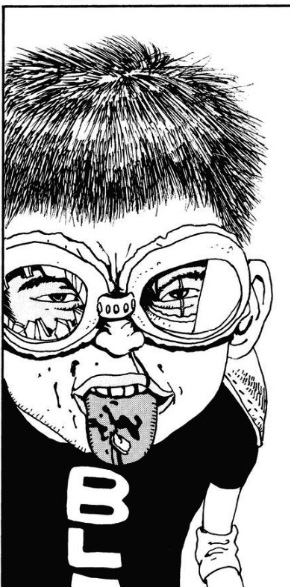
Perhaps our most anticipated episode, TekkonKinkreet is a manga that’s had a powerful effect on many readers and comic creators, including this week’s host Christopher. Will Chip Zdarsky like the book? Will him disliking it form a rift that tears the podcast asunder? Probably not, but Deb, David, Christopher and Chip dig into this very widely-loved manga, with some interesting behind-the-scenes stories!
Powered by RedCircle
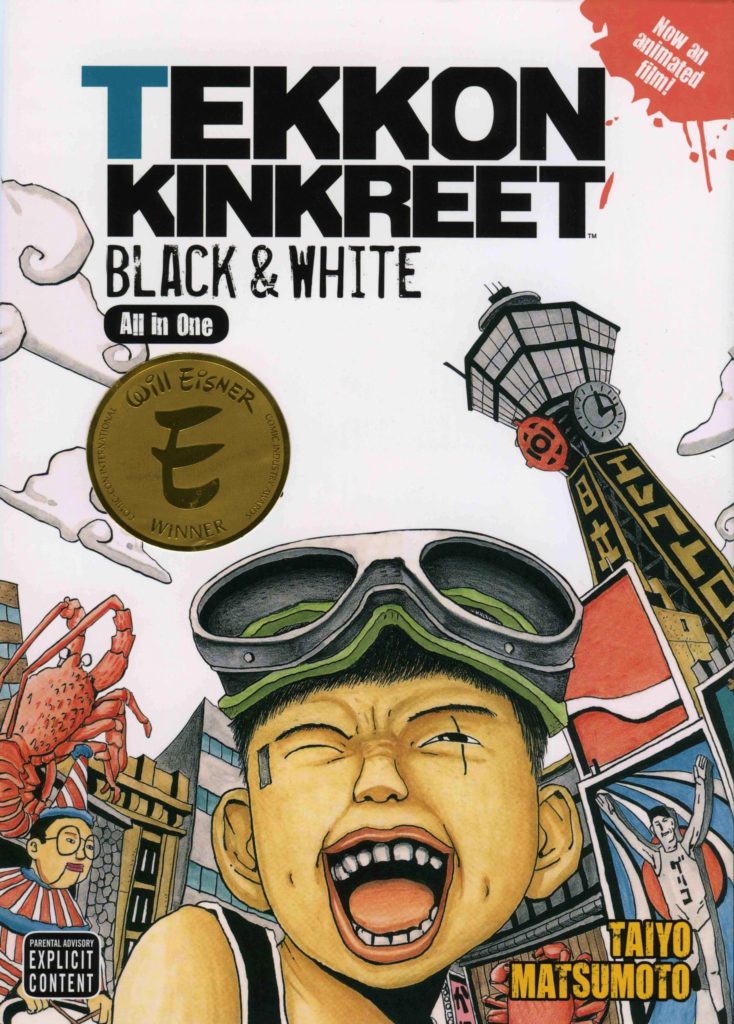
TekkonKinkreet Black & White (All-in-one edition)
鉄コン筋クリート
By Taiyo Matsumoto
Published by VIZ Media. Available in Print & Digital.
Translation by Lillian Olsen. Touch-up Art & Lettering by Cynthia Bergst.
Touch-up art and Lettering Assistance by Vanessa Satone and Walden Wong.
Edited by Andrew McKean, Annette Roman, Jason Thompson, and Elizabeth Kawasaki.
Before we start:
Major spoilers for this manga, even moreso than usual!
At time of recording this book was between printings due to the paper and printing capacity shortages affecting the manga industry right now. It will likely be back in print asap, but there are also almost certainly copies available at many stores across North America.
Alright, let’s get to it:
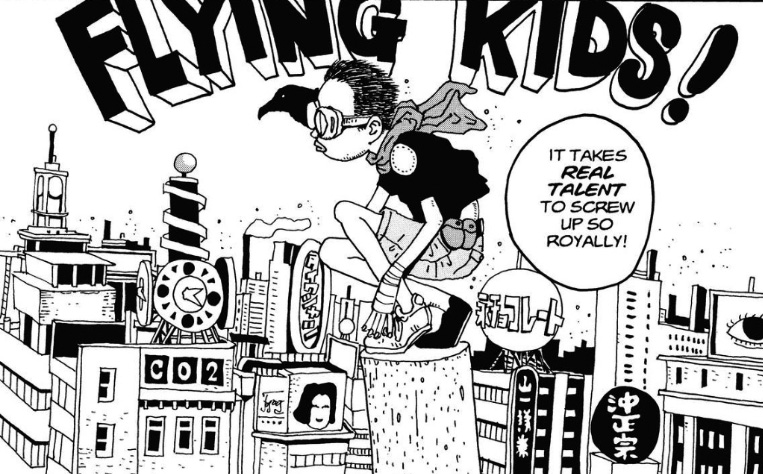
1:40: Chip was actually writing stories featuring The Batman and The Daredevil as this podcast was being recorded, so this may have been a joke aimed directly at him. 🙂
2:40: VIZ was, in fact, fat with Pokemon money, as the success of the Pokemon manga exclusively published by VIZ was massive at the time.
2:50: The TekkonKinkreet 3-in-1 edition from VIZ is a rare manga published close to the North American comic book size, which is more-or-less the size of the anthology magazines published in Japan. It replaced three separate volumes in a smaller ‘manga’ sized format that were published between 1998 and 2000. This edition of the manga has been in print more-or-less continuously since 2007. The current edition is pictured above, the previous editions are shown below:
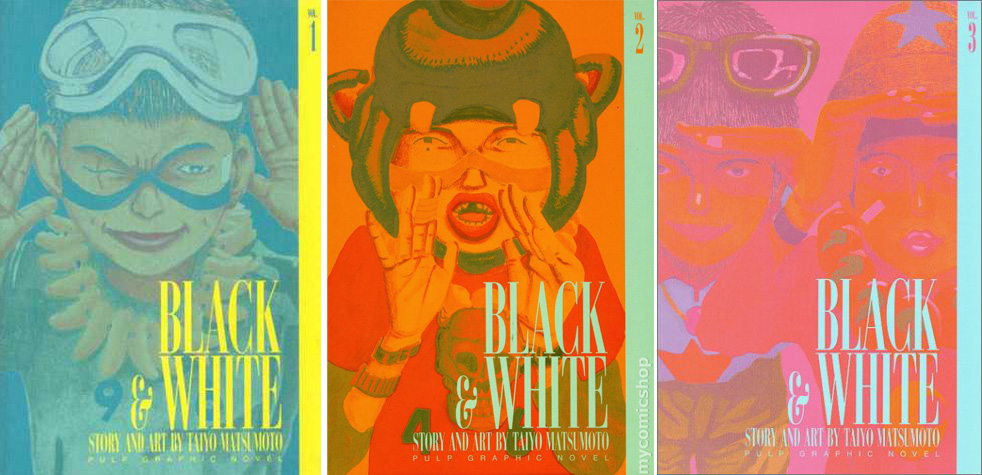
3:30: We mention the animated adaptation here, directed by Michael Arias. It’s a very close adaptation of the manga, and it’s very good, and we don’t really talk about it because… well, we needed to set some parameters on this episode because it could’ve gone on much, much longer. Track down the Blu-ray, it’s not available on streaming unfortunately. It’s a visual feast.
That’s the trailer, which is only available on the official production company YouTube channel at 360p, which is hilarious because the past is low res. Anyway, this should give you a sense of it.
5:29: Okay, there’s a warning folks. The digital manga on Apple Books is formatted incorrectly, hopefully by the time this episode goes live it’ll be fixed. It works find on the VIZ website though…!
And yes, this is a ‘flipped’ manga, reading in the left-to-right reading orientation. Like AKIRA! Sort of!
6:50: The first 20 pages are available as a free preview on the VIZ website, alongside an interview between Matsumoto and the film’s director Michael Arias.
7:15: Wow, that’s a smorgasbord of creators we mention in quick succession! Here’s a little bit more about their work.
Moebius (real name: Jean Giraud, 1938-2012) is a pioneering and incredibly influential French comics artist (BD, Bande Desinee) who is best known for his works Arzach, Airtight Garage, Blueberry, and The Incal. He’s a foundational creator, and one of the co-founders of the comics magazine Metal Hurlant, brought to North America as Heavy Metal Magazine, which also many other foundational and influential creators over the years. Wiki: https://en.wikipedia.org/wiki/Jean_Giraud
Simon Bisley is a British comics creator who actually ended up contributing to the American Heavy Metal at one point, but if best known for his work on ABC Warriors, Slaine, and Lobo. https://en.wikipedia.org/wiki/Simon_Bisley
Seth Fisher (1972-2006) was an American comic creator whose work was influenced by Japanese manga and European Bande Desinee. His notable works include Happydale, Vertigo Pop: Tokyo, and Flash: Time Flies. https://en.wikipedia.org/wiki/Seth_Fisher
Julie Doucet is an amazing Canadian cartoonist best known for her graphic novel My New York Diary, and the comic book series Dirty Plotte. Her work is very bold and graphic, and includes very idiosyncratic versions of the cities she features, including New York City and Montreal. https://en.wikipedia.org/wiki/Julie_Doucet
11:00: Worth noting that the animated film makes more explicit, in a very quick sequence, Black’s childhood trauma, as it is depicted on screen, and that scene is not included in the manga. It’s the biggest change between the two media, and I think it was approved by Matsumoto so I’m fairly convinced it’s ‘canon’ for whatever that means.
12:20: It’s true! Deb’s on the TekkonKinkreet wikipedia page! She gave the book 4.5 out of 5. 🙂
13:20: This really is Osaka. Sort of. We talk about it a lot more towards the end of the podcast, but the setting of the manga, TreasureTown, is based on (and inspired by) the Shinsekai (‘new world’) area of Osaka. Here’s a link to a blog post talking about the area.
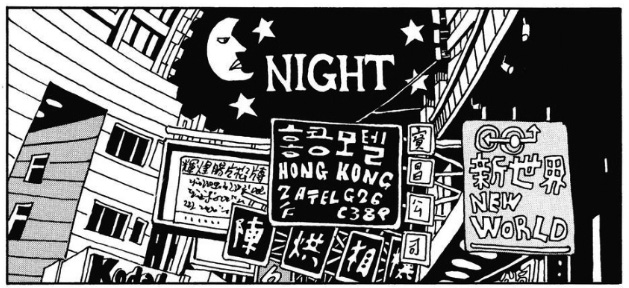
14:20: Just for reference, here’s the release order for Taiyo Matsumoto’s manga!
Straight, Zero, Hana Otoko, Blue Spring, TekkonKinkreet: Black & White, Brothers of Japan, Ping Pong, GoGo Monster, No. 5, Hana, Takemitsuzamurai, Sunny, Cats of the Louvre.
Bolded titles were published in English, or are about to be published in English. Complete the set! He’s also working on two ongoing series right now, Mukashi no Hanashi with Issei Eifuku, the writer of Takemitsu Zamurai, and Tokyo Higoro, a semi-autobiographical manga about the manga publishing industry…! You can read a preview of the latter manga here: https://big-3.tameshiyo.me/HIGORO01ORI
22:15: So when I talked to Taiyo Matsumoto about his French comics influences, he mentioned reading a bunch of stuff while he was in France when he was younger, but the only artist he references by name is Enki Bilal. Bilal is a French comics author who is best known for comics (BD) like The Nikopol Trilogy, The Black Order Brigade, and The Hunting Party among many others. The two artists have contributed to the same anthology book, The Tipping Point, which Christopher mistakenly called turning point, published by Humanoids. The cover is below.
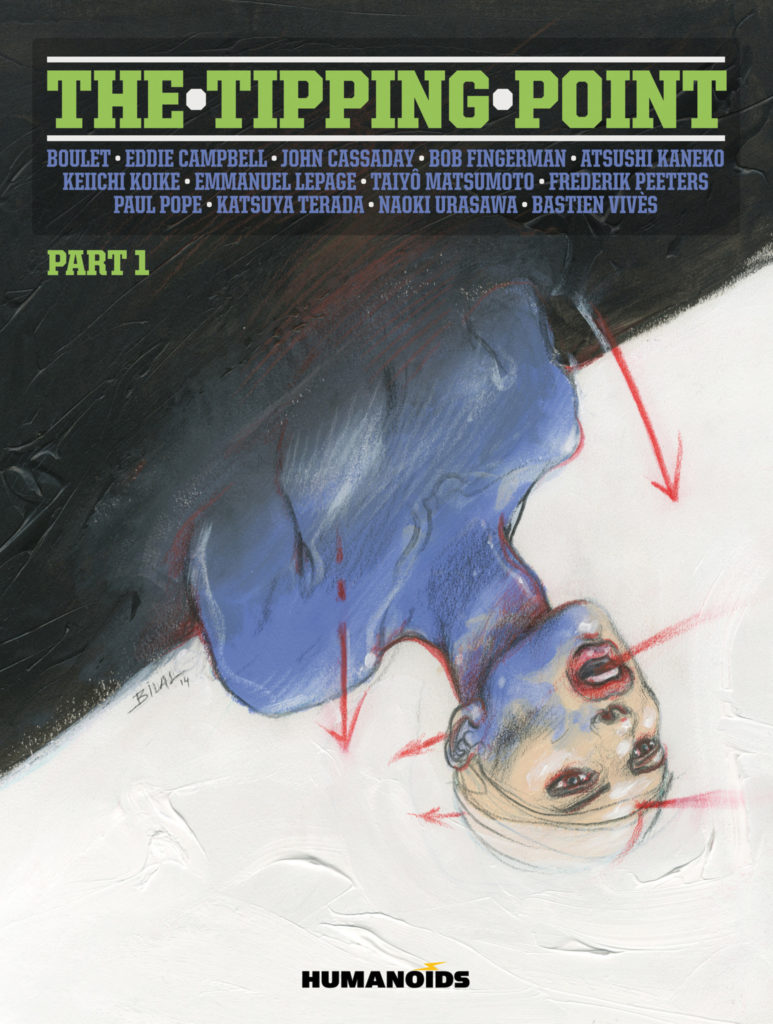
24:00: Shonen Fighting spirit is like, well it’s almost a cliche at this point but it’s this idea prevalent in shonen manga about like friendship, succeeding at any cost, trying harder when the chips are down. It’s ever-present in manga and anime. Here’s a picture of a t-shirt on Redbubble that mentions it. It may or may not be stolen, it’s tough to tell with Redbubble.
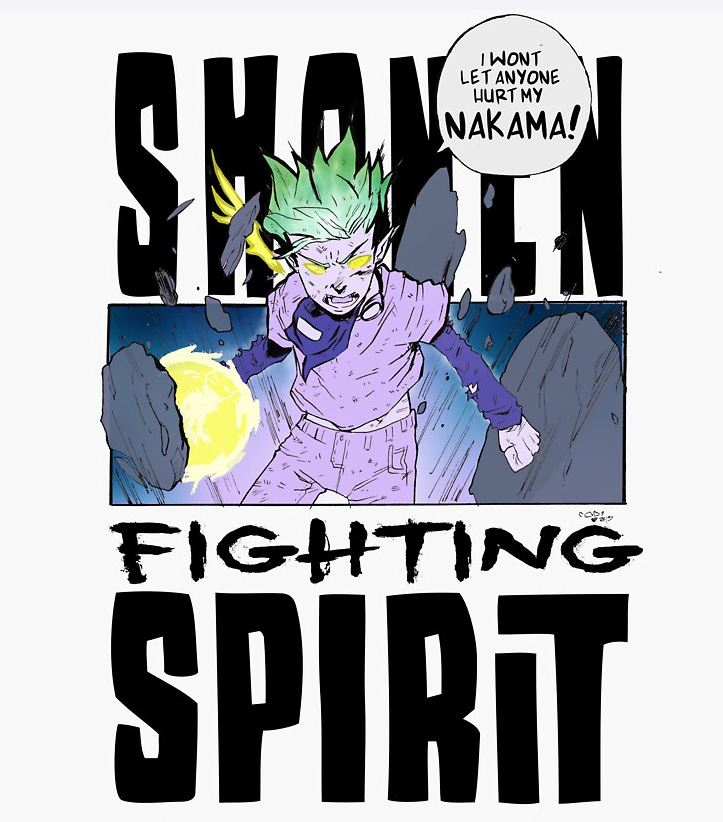
30:00: “When ya thinks about dying and stuff.” Yeah there’s some rough/funny stuff in here.
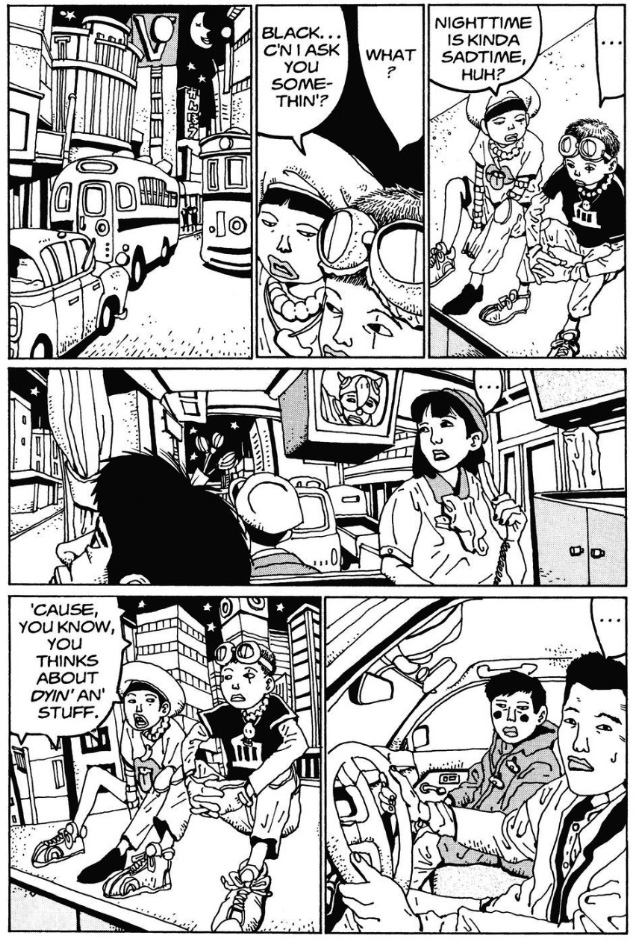
31:00: So yeah, White is wearing a Kamen Rider belt for the first few chapters. The idea of being, or playing at being, a superhero. Creator Taiyo Matsumoto would go back to this idea in Ping Pong, his next major work.
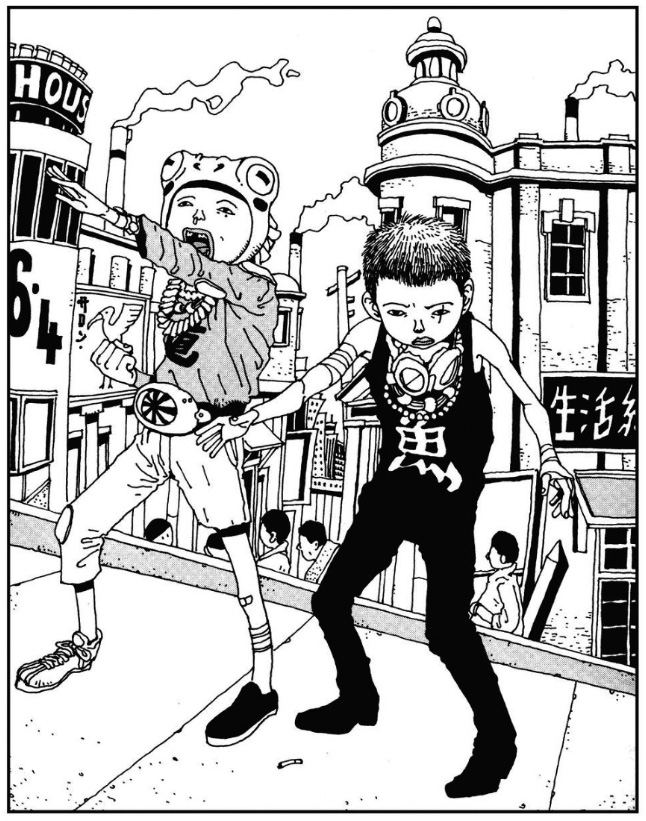
…and yes, David is close personal friends with Kamen Rider.
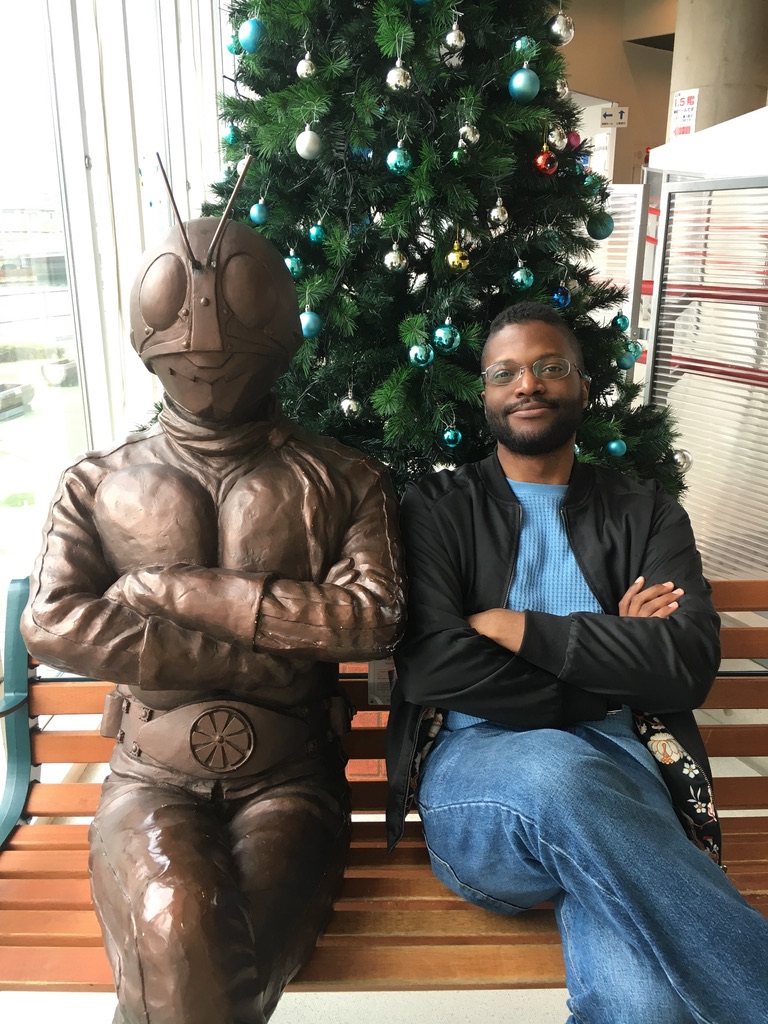
33:20: Oh White, don’t peak over the sento walls.
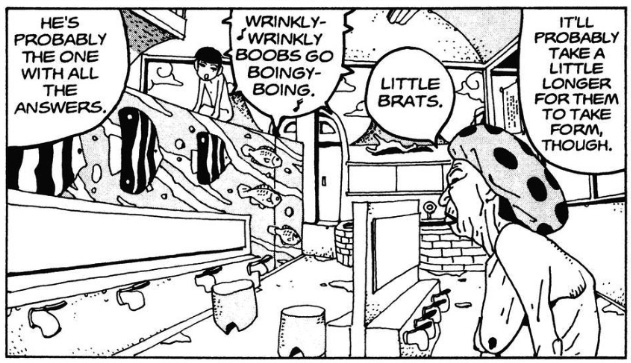
33:45: LOOK I HAD TO MENTION THE DIFFERENCE. We’re a respected podcast! So yeah, sento are normally neighbourhood bathhouses, dating back to before people had showers/bathtubs in their home (which didn’t really start happening until after WWII), and generally use filtered tap water (though there might be extra things added to the water to make it healthier). Onsen are also bathhouses, but tend to be ‘fancier’, and feature naturally sourced spring water naturally rich with minerals and things. We did take Chip to 2 onsens, but no sento unfortunately. Next time. And yeah, the one in TekkonKinkreet is a sento.
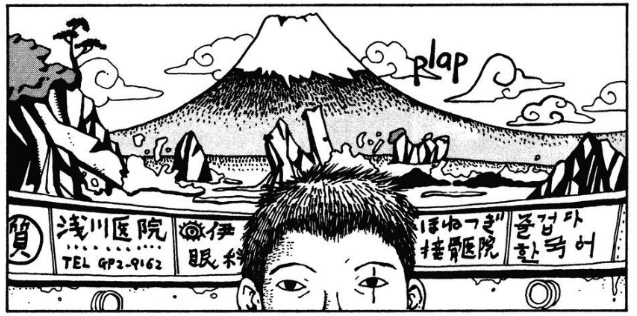
Also here’s a video explaining the difference:
37:16: David calls out some great violent imagery, but this is only the tip of the iceberg…!
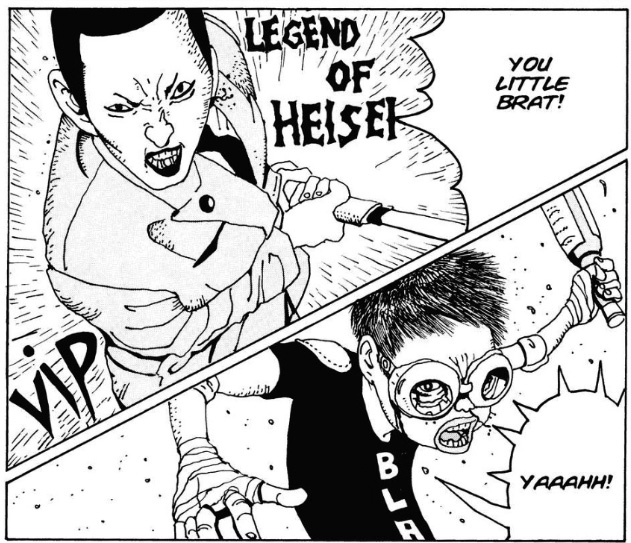
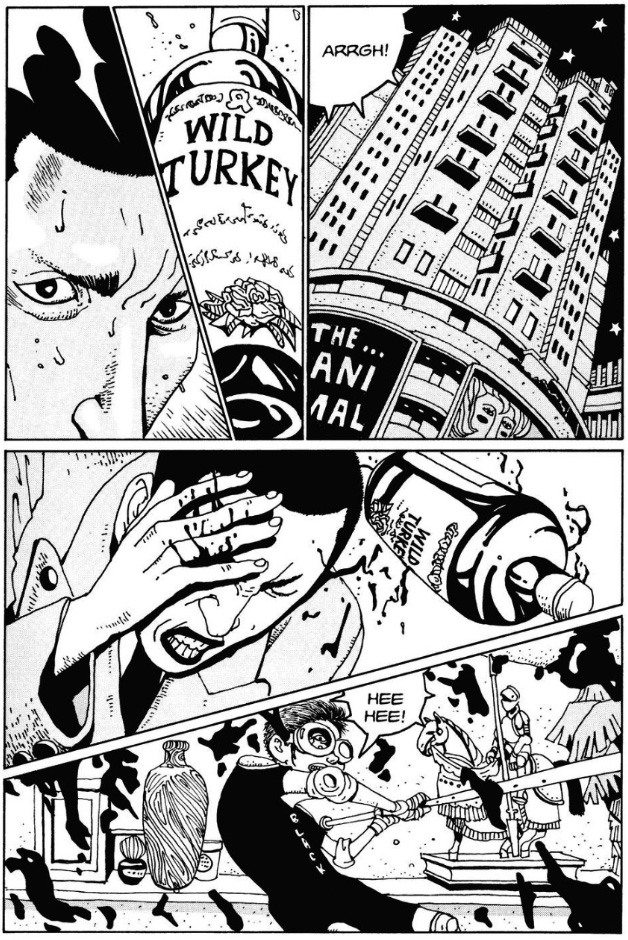
42:15: That is an amazing turn of phrase that David drops here, “‘I believe in my friend!’ is the power chord of shonen manga.” That’s… actually that’s what’s on that “Shonen Fighting Spirit” image up there. Nakama means like ‘best friend.’ So there you go. 😉
44:20: That’s Saho Tono, an outstanding comics creator and illustrator, and is also married to Matsumoto. Saho started assisting Matsumoto with his manga as far back as Ping Pong, I believe, before contributing production and other duties to his later work. She’s been a big influence on Matsumoto, as you can see with the stylistic shifts of his work Takemitsuzamurai and Sunny, which feature ink washes and other evolutions. Unfortunately none of her solo work has been translated into English, but she is credited as co-creator of Cats of The Louvre alongside her husband… on the interior. Don’t blame VIZ on this one, this is a licensing thing. Anyway she’s awesome, somebody please translate her comics.
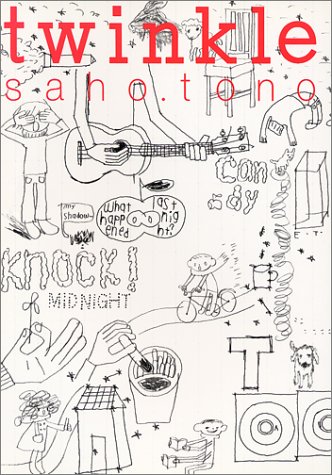
46:45: This whole sequence with the death of Kimura is so good that… you’ve gotta read it. Sorry, we’re not going to spoil it for you. Buy the book! But that line he gives to Kimura’s girlfriend, that we’ll show you.
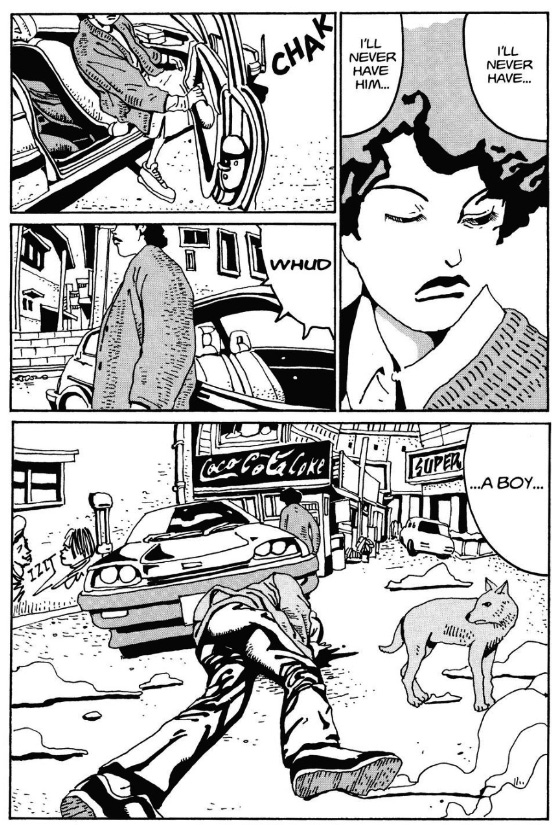
48:25: So yeah, Chip didn’t like the colour pages which is like, his prerogative (they’re not my fav tbh), but the gag where Kimura turns blue on this page IS pretty good.
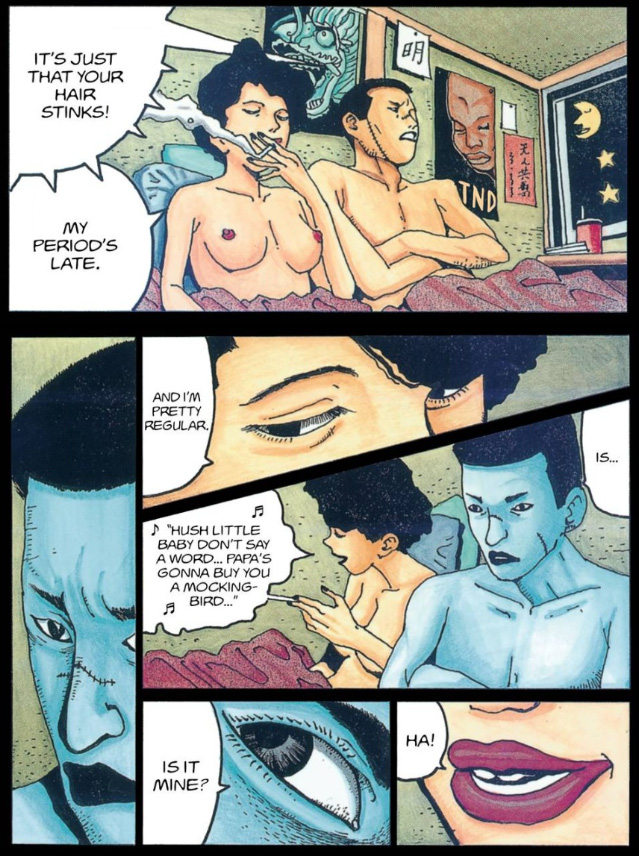
51:15: As David mentions, while the book as a whole has been printed to read in the North America, left-to-right reading order, individual panels were kept in the Japanese orientation, to assist in the clarity of the individual panel’s reading order. Think: ‘cut & paste’. The unflipped panels are usually there when flipping them would ‘break’ the story in a major way, like if there’s a lot of text in the background or it just doesn’t read right. This used to happen with more regularity in manga translation but is far out of fashion these days, thankfully. Another sign that this book has been kept in print in this edition for quite some time, longer than most manga in print today.
56:22: Yeah that earlobe on the tongue image is a lot… and probably someone somewhere got a tattoo of it.
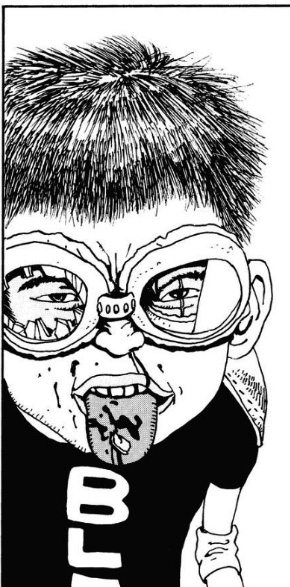
1:00:56: Spa World! It’s wild. I’ve sadly never been, but a number of friends highly recommend it. You should check out the website, it’s actually fantastic. https://www.spaworld.co.jp/english/
1:02:40: The Break! Please remember that after this point times are all approximate depending on how long the ad went.
1:03:30: Yeah not feeling “Mangang,” but appreciate the love and the question! 🙂
1:03:45: Christopher and Deb go pretty in depth with this answer, it doesn’t need a lot of glossing, but you can find occasionally find an original page show up on the Mandarake auction website, or at Mandarake in Japan. There are other shops and online sites that will offer some too, but these pages are almost never from popular creators in the west. If you want one of those pages, you have to go straight to the artist in Japan, or find an agent who’s willing to do so.
Also worth noting, finding a sketch or autograph for sales is still pretty rare, but MUCH less rare than finding an original manga. As Deb mentions, she’s seen a sketch by Leiji Matsumoto for sale.
1:08:30: Yoshiharu Tsuge is a pioneering ‘underground’ manga creator originally published in Garo magazine in Japan. Best known for his manga Screw Style published in The Comics Journal more than a decade ago, his work is now finally appearing in print in North America. Drawn & Quarterly has released his works The Swamp and Red Flowers, and the New York Review of Comics has released The Man Without Talent.
It should be noted that Yoshiharu Tsuge’s younger brother, Tadao Tsuge, started to be published in English a few years back, in 2015! His works include Trash Market from Drawn & Quarterly, and Slum Wolf from New York Review Books.
1:13:30: Turns out that image printed on the inside of the dust jacket of Tekkon Kinkreet isn’t included in the digital edition! Here it is for those of you at home:
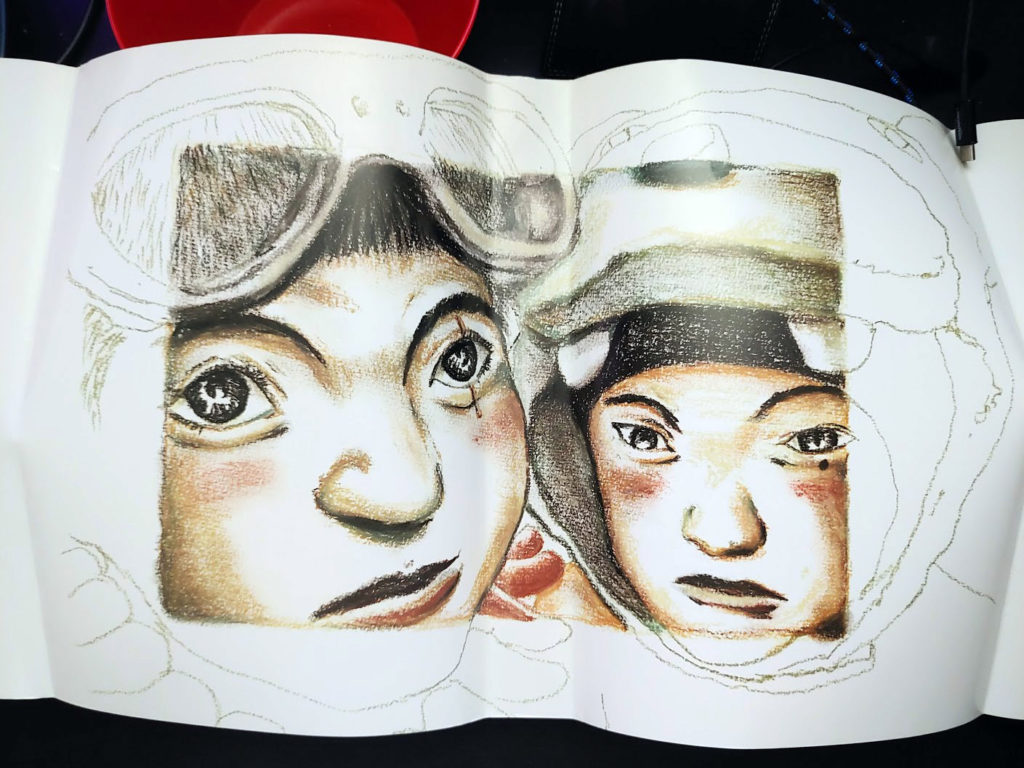
1:14:00: Reproduction pages are super cool! Deb references a very high-end reproduction by Keiko Takemiya produced in partnership with the Kyoto International Manga Museum. These aren’t for sale, but are for loan to galleries, and they’re nearly indistinguishable from the originals in many cases, it’s pretty great. Check out this digital book that explains the process produced by the Kyoto Manga Museum, called Genga Dash! https://issuu.com/curiousroad/docs/gengadash2b
There are also more affordable reproductions of famous scenes and pages. If you’re ever near a Shonen Jump theme shop in Tokyo, there are usually 6-10 reproductions available of various Jump series, contemporary and classic. Here’s a listing of some of the goods from that shop, including some One Piece reproductions: http://www.shonenjump.com/j/jumpshop/202012item/
It’s time to pick new books!
The next round of suggestions are:
Paradise Kiss, by Ai Yazawa
Naruto, by Masashi Kishimoto
The Strange Tale of Panorama Island, by Suehiro Maruo
So that means that the upcoming books on Mangasplaining are:
Ep. 11: Fullmetal Alchemist, by Hiromu Arakawa. Published by VIZ Media. (Apr 27)
Ep. 12: Oishinbo, by Tetsu Kariya and Akira Hanasaki. Published by VIZ Media. (May 4)
Ep. 13: Beastars, Vol 1, by Paru Itagaki. Published by VIZ Media. (May 11)
Ep. 14: Paradise Kiss 20th Anniversary Edition, by Ai Yazawa. Published by Vertical Inc./Kodansha. (May 18)
Ep. 15: Naruto Vol 1, by Masashi Kishimoto. Published by VIZ Media.
Ep. 16: The Strange Tale of Panorama Island, by Suehiro Maruo. Published by Last Gasp.
That’s it! Thanks so much for listening to this episode, see ya next week!
Oh, and those links again are:
Comicshoplocator.com
D.A.D.S. on Spotify
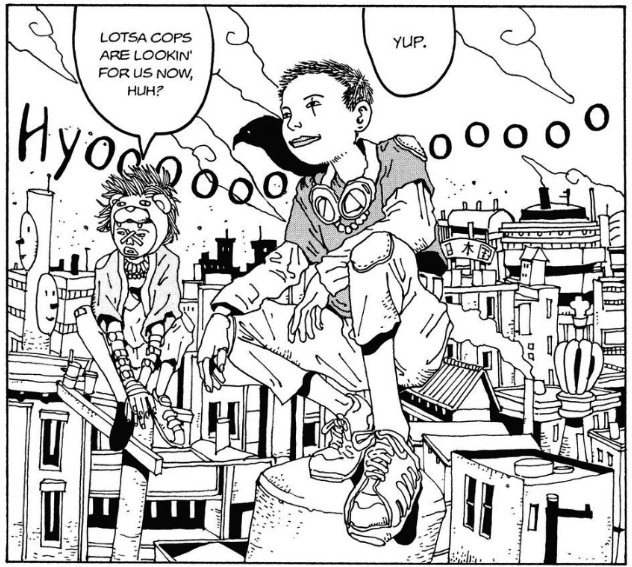
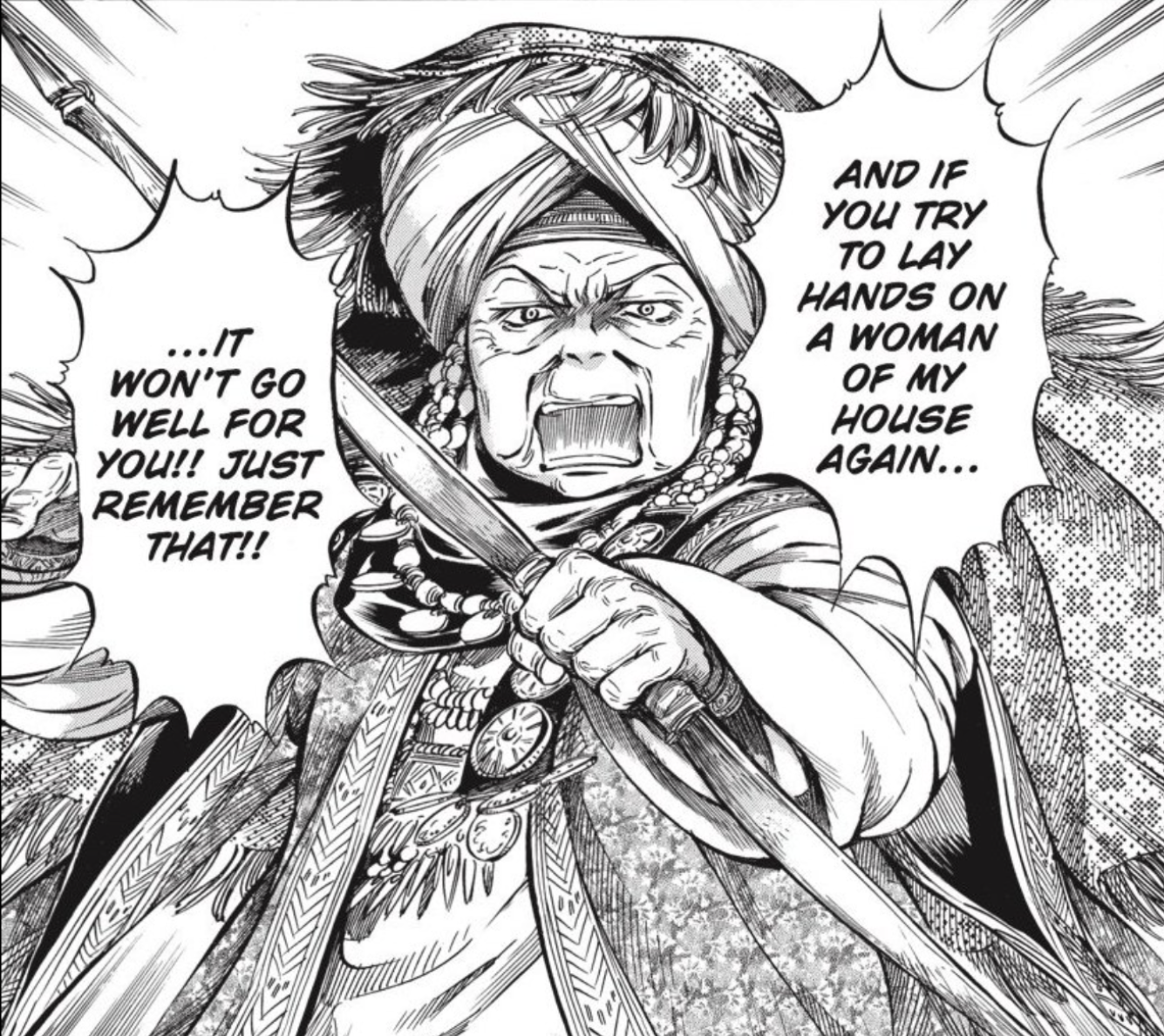
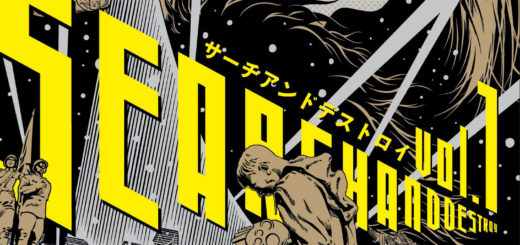
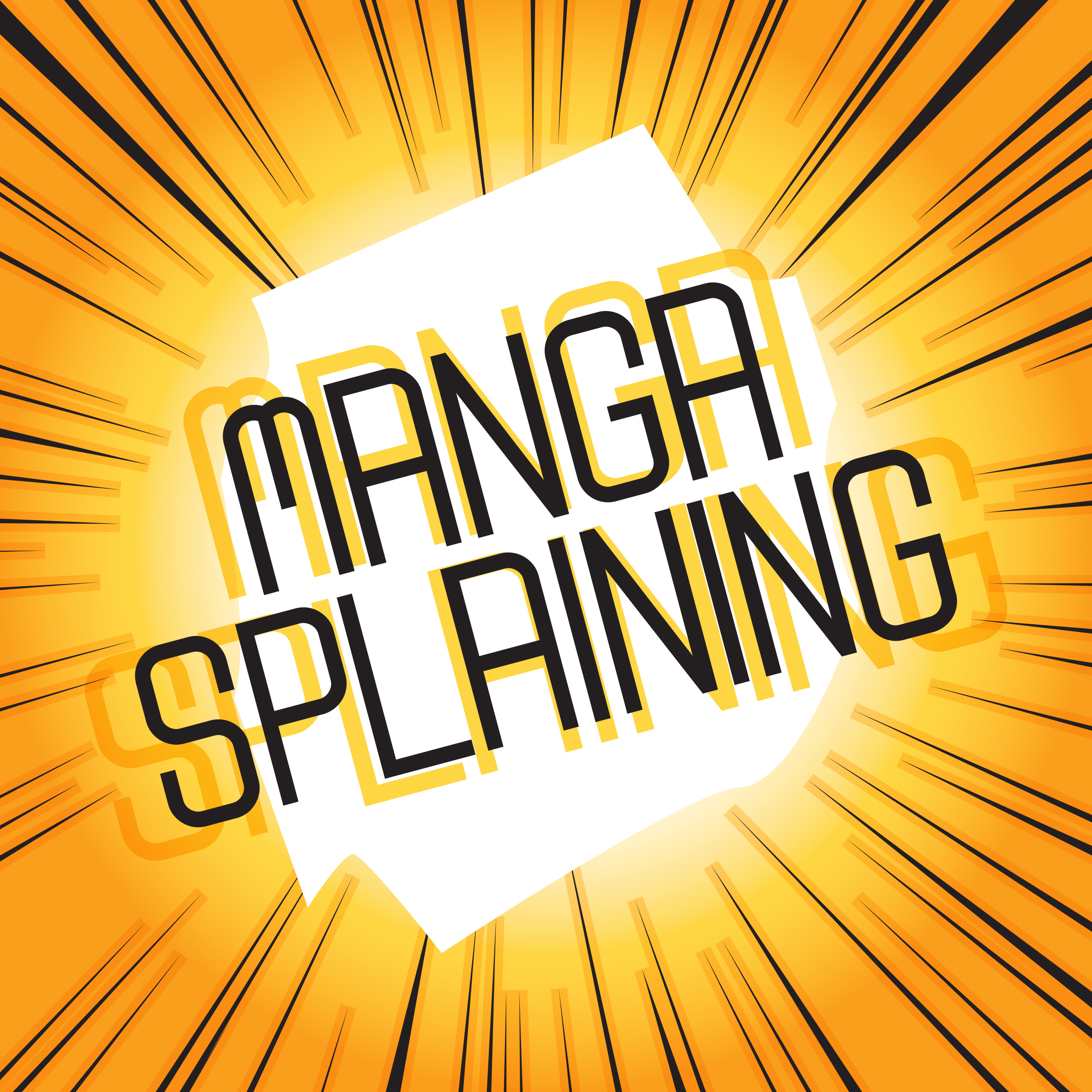
I’m glad Deb jokingly referred to Black and White as anti-gentrification forces at the end because it was definitely a (probably unintentional?) theme I picked up in the first half of this.
Yeah that part of it is a huge part of the contemporary reading. Even more relevant now than it was 20 years ago.
I was one of those ~500 people who bought No. 5, vol. 2 when it first came out all those many years ago based on Chris’ recommendation. I lent my copies to someone I haven’t seen in over a decade ago though, so they’re gone forever.
I seem to recall that later volumes of another Viz series (maybe Firefighter! Daigo of Fire Company M?) ended up selling even fewer copies than No. 5. I’d love to know what the worst selling manga in English is, though I doubt any publisher is going to reveal that info.
Oh yeah, several series are doing very poorly as their volume counts reach into the 60s and 70s, they’re not picking up new readers. Maybe it’s more important to say that, at the time of publishing, it was the lowest. So low that they cancelled the series.
Thanks for answering my question. I did not expect such an in-depth answer, that was incredibly informative! As an artist who doesn’t care about his originals (besides the fact that someone might one day want them and making a living is hard so I gotta store them) I related a lot.
I just binged all current episodes while doing some reading between in just a few days. I’m amazed by how much work you put into these along with these extensive shownotes.
If ever there was an episode of this show I wish I could have been on, it was definitely this one. Not that you didn’t cover everything or due justice to the work. I just find this book so engaging, with a depth that rewards rereading.
I have to say, I first bought this in 2006, and like everyone on the show, I too bounced after the first 20 pages or so. It wasn’t the art or presentation so much as the language itself. Black and White speak very idiosyncratic slang, and not common Japanese slang, but their own unique argot that makes reading it hard to parse. The grammar and syntax of much of the dialogue has a very non sequitor feel to it, so it’s hard to get absorbed by it. (White’s made-up songs, however, work 100% of the time.) I remember watching the movie with a Japanese friend, before I ever completely finished the manga, and he asked to turn the subtitles on because he just likes them. I was cool with that because I’m not a native speaker so I’ll take an assist. By the end of the film he turned to me and said, were it not for the subtitles he wouldn’t have understood half of what they said. Take from that what you will, but it took me a 1/3 of the way through the book to really get into the language. Seeing the translated pages, I can see the translator/s took pains to smooth that out, so kudos to them.
Speaking of the translation, I find it interesting that all the non-standard names were actually translated (Kuro -> Black, Shiro -> White, Nezumi -> Rat). Even Treasure Town is not Takara-machi. Not a quibble, mind you, just an interesting note. I suppose without those direct translations some of the metaphor would be lost, like when Kimura declares his child’s name will be called Truth. I wonder how the translators and editors reached that decision.
It’s weird that you said Osaka, especially Shinsekai, was the model for the Treasure Town. Looking at the cover of the English edition, yeah, that’s straight-up Osaka (Dotonbori to be exact), but reading this? I didn’t feel the Osaka at all. It was like watching movies or TV shows shot in Vancouver where everyone is claiming they’re in NYC. No one in the comic uses Osaka dialect, and no one acts like they’re from Osaka either. No, I can’t quantify that aside from the fact that I live in Osaka. Again, you can say it’s Osaka, but it’s like every TV show filmed in Vancouver claiming New York. A pastiche, maybe. (Interestingly enough, many Japanese people online think the Treasure Town in the movie version is based on Daikanyama or Shimokitazawa in Tokyo. Go figure.) I can definitely *see* the Osaka in the art, but I don’t *feel* it.
I’m glad David called out all the animal familiars popping up everywhere. What really drove home for me we’re seeing the town through the kids’ eyes was the animals, which looked like the concrete animals you’ll find at parks in Japan. They don’t move or or do anything; you can only sit on them. They’re a weird piece of playground equipment, but I could see White considering them real.
Finally, you hit on everything I would say about the art, but I think at the top of the show, Chip (?) mentioned all the angles, and man, even the Dutch angles have Dutch angles. I really like how Matsumoto is not afraid to get all over the place with the camera, even kind of sloppily–in a good way!–without really hurting the pacing or the flow. I think it really feeds into the disorienting nature of the city he’s trying to convey. You really get that busyness of a heavily populated city where you can’t really take in the sights except sporadically because you have to keep an eye on where you’re going lest you bump into something. And then some kid beats you up with a long-ass pipe.
Hi Miguel, This is really a detailed response to our podcast, thanks so much for your thoughts! In terms of not ‘feeling’ like Osaka, I think that’s really fascinating. I know Matsumoto only lived near Osaka when he was young, for a short time. Maybe his impressions of Osaka are shaped on that very different, immature experience, as compared to how Osaka feels as an adult? It’s also worth noting that they took great pains to like, specifically not set it in a named place. I have no doubt that the film’s director pulled from lots of different areas to make the movie, but both Daikanyama post-renewal and Shimokita feel too small, far too small, and too… upscale, to give me Treasure Town vibes. Maybe before the renewal, but I doubt you’d find a rusted out… anything… in either area these days? Or at least 15 years ago when the movie was made. But when I visited Shinsekai for the first time, it “felt” like Treasuretown to me. Maybe it’s not the same in reverse though. Heh. 😉
For more of an Osaka feeling, I’d love to know what you think about ‘Sunny’?
Thanks for the reply! And my detailed response pales in comparison to the quality of the show notes for every episode.
One thing I did forget while reading is this strip originally ran in the mid-nineties, so even the Osaka from then is much different from the one that currently exists. It’s very possible that I’m so used to post-gentrified Osaka that the vibe from Treasure Town just feels different. I do agree–and like–that he never outright states where Treasure Town is. It’s funny that Japanese commenters on different sites all have different opinions, but many of them think that the movie version is not the same as manga version, as it it more a reflection of the director’s experiences. All in all, I can totally see the Shinsekai vibe you get from it. I can say with certainty is doesn’t look like Kyoto at all. 🙂
Another thing is I may just be used to more traditional manga where if the characters visit Osaka, the author make sure you know you’re in Osaka, right down to the obligatory Kansai dialect speaking guide. (In “Cased Closed,” Conan even solves a case based on the Osaka dialect. Would LOVE to see how that was translated.)
Have not had a chance to read “Sunny” yet, but will definitely check it out. Thanks!
By the way, here’s an article where the author tries to suss out the exact corresponding street in Tokyo that could have inspired the Treasure Town from the anime. It’s in Japanese, but some neat pictures of Tokyo. The author does mention, however, that Treasure Town is meant to be an undisclosed downtown area of “Anywhere, Japan” in the Showa era. Probably more of interest to those who’ve seen the anime than those who have read the manga.
https://taikan-enta.info/tekkon-takaramachi/
This is finally getting a reprint! If anyone else has been wanting to read it physically